Deficit Irrigation at Pre-Anthesis Can Balance Wheat Yield and Water Use Efficiency under Future Climate Change in North China Plain
Abstract
:Simple Summary
Abstract
1. Introduction
2. Materials and Methods
2.1. Study Site, Soil Data, and Historical Climate Data
2.2. Field Experiment Data
2.2.1. Auto-Rain-Shelter Experiment in 2017–2018
2.2.2. Field Experiment in 2014–2018
2.3. APSIM-Wheat Model
2.4. Model Simulations
2.4.1. Future Climate Data
2.4.2. Settings for Different DI and N Fertilizer Rates
2.5. Calculation of Future Changes in Yield, WUE Changes, and DI Compensation Effect
3. Results
3.1. Performance of the APSIM-Wheat Model and Its Parameterization
3.2. Future Climate Projections
3.3. Projected Winter Wheat Phenology Change
3.4. Projected Changes in Yield and WUE
3.5. Wheat Yield and WUE Relationships with Future Climate
3.6. Projected Compensation Change of DI3 on Yield and WUE
4. Discussion
5. Conclusions
Supplementary Materials
Author Contributions
Funding
Institutional Review Board Statement
Informed Consent Statement
Data Availability Statement
Acknowledgments
Conflicts of Interest
References
- Yilmaz, O.; Kazar, G.A.; Cakmak, I.; Ozturk, L. Differences in grain zinc are not correlated with root uptake and grain translocation of zinc in wild emmer and durum wheat genotypes. Plant Soil 2017, 411, 69–79. [Google Scholar] [CrossRef]
- Agami, R.A.; Alamri, S.A.; Abd El-Mageed, T.A.; Abousekken, M.; Hashem, M. Role of exogenous nitrogen supply in alleviating the deficit irrigation stress in wheat plants. Agric. Water Manag. 2018, 210, 261–270. [Google Scholar] [CrossRef]
- Cao, S.; Xu, D.; Hanif, M.; Xia, X.; He, Z. Genetic architecture underpinning yield component traits in wheat. Theor. Appl. Genet. 2020, 133, 1811–1823. [Google Scholar] [CrossRef] [PubMed]
- Knox, J.; Daccache, A.; Hess, T.; Haro-Monteagudo, D. Meta-analysis of climate impacts and uncertainty on crop yields in Europe. Environ. Res. Lett. 2016, 11, 113004. [Google Scholar] [CrossRef]
- Xin, Y.; Tao, F. Optimizing genotype-environment-management interactions to enhance productivity and eco-efficiency for wheat-maize rotation in the North China Plain. Sci. Total Environ. 2019, 654, 480–492. [Google Scholar] [CrossRef]
- Parry, M.A.J.; Hawkesford, M. Food security: Increasing yield and improving resource use efficiency. Proc. Nutr. Soc. 2010, 69, 592–600. [Google Scholar] [CrossRef] [Green Version]
- Deihimfard, R.; Eyni-Nargeseh, H.; Mokhtassi-Bidgoli, A. Effect of Future Climate Change on Wheat Yield and Water Use Efficiency Under Semi-arid Conditions as Predicted by APSIM-Wheat Model. Int. J. Plant Prod. 2018, 12, 115–125. [Google Scholar] [CrossRef]
- Saddique, Q.; Liu, D.L.; Wang, B.; Feng, P.; He, J.; Ajaz, A.; Ji, J.; Xu, J.; Zhang, C.; Cai, H. Modelling future climate change impacts on winter wheat yield and water use: A case study in Guanzhong Plain, northwestern China. Eur. J. Agron. 2020, 119, 126113. [Google Scholar] [CrossRef]
- Asseng, S.; Ewert, F.; Martre, P.; Rotter, R.P.; Lobell, D.B.; Cammarano, D.; Kimball, B.A.; Ottman, M.J.; Wall, G.W.; White, J.W.; et al. Rising temperatures reduce global wheat production. Nat. Clim. Chang. 2015, 5, 143–147. [Google Scholar] [CrossRef]
- Lesk, C.; Rowhani, P.; Ramankutty, N. Influence of extreme weather disasters on global crop production. Nature 2016, 529, 84–87. [Google Scholar] [CrossRef]
- Zhao, C.; Liu, B.; Piao, S.; Wang, X.; Lobell, D.B.; Huang, Y.; Huang, M.T.; Yao, Y.T.; Bassu, S.; Ciais, P.; et al. Temperature increase reduces global yields of major crops in four independent estimates. Proc. Natl. Acad. Sci. USA 2017, 114, 9326–9331. [Google Scholar] [CrossRef] [PubMed] [Green Version]
- Wang, B.; Liu, D.; Asseng, S.; Macadam, I.; Yang, X.; Yu, Q. Spatiotemporal changes of wheat phenology, yield and water use efficiency under the CMIP5 multimodel ensemble projections in eastern Australia. Clim. Res. 2017, 72, 83–99. [Google Scholar] [CrossRef]
- Rashid, M.A.; Jabloun, M.; Andersen, M.N.; Zhang, X.; Olesen, J.E. Climate change is expected to increase yield and water use efficiency of wheat in the North China Plain. Agric. Water Manag. 2019, 222, 193–203. [Google Scholar] [CrossRef]
- Rezaei, E.E.; Siebert, S.; Hüging, H.; Ewert, F. Climate change effect on wheat phenology depends on cultivar change. Sci. Rep. 2018, 8, 4891. [Google Scholar] [CrossRef] [Green Version]
- Wang, B.; Liu, D.L.; Evans, J.P.; Ji, F.; Waters, C.; Macadam, I.; Feng, P.; Beyer, K. Modelling and evaluating the impacts of climate change on three major crops in south-eastern Australia using regional climate model simulations. Theor. Appl. Climatol. 2019, 138, 509–526. [Google Scholar] [CrossRef]
- Fang, Q.; Zhang, X.; Shao, L.; Chen, S.; Sun, H. Assessing the performance of different irrigation systems on winter wheat under limited water supply. Agric. Water Manag. 2018, 196, 133–143. [Google Scholar] [CrossRef]
- Si, Z.; Zain, M.; Mehmood, F.; Wang, G.; Gao, Y.; Duan, A. Effects of nitrogen application rate and irrigation regime on growth, yield, and water-nitrogen use efficiency of drip-irrigated winter wheat in the North China Plain. Agric. Water Manag. 2020, 231, 106002. [Google Scholar] [CrossRef]
- Yan, Z.; Zhang, X.; Rashid, M.A.; Li, H.; Jing, H.; Hochman, Z. Assessment of the sustainability of different cropping systems under three irrigation strategies in the North China Plain under climate change. Agric. Syst. 2020, 178, 102745. [Google Scholar] [CrossRef]
- Qin, W.; Zhang, X.; Chen, S.; Sun, H.; Shao, L. Crop rotation and N application rate affecting the performance of winter wheat under deficit irrigation. Agric. Water Manag. 2018, 210, 330–339. [Google Scholar] [CrossRef]
- Xu, X.; Zhang, M.; Li, J.; Liu, Z.; Zhao, Z.; Zhang, Y.; Zhou, S.; Wang, Z. Improving water use efficiency and grain yield of winter wheat by optimizing irrigations in the North China Plain. Field Crops Res. 2018, 221, 219–227. [Google Scholar] [CrossRef]
- Faloye, O.; Alatise, M.; Ajayi, A.; Ewulo, B. Effects of biochar and inorganic fertiliser applications on growth, yield and water use efficiency of maize under deficit irrigation. Agric. Water Manag. 2019, 217, 165–178. [Google Scholar] [CrossRef]
- Meena, R.P.; Karnam, V.; Tripathi, S.; Jha, A.; Sharma, R.; Singh, G. Irrigation management strategies in wheat for efficient water use in the regions of depleting water resources. Agric. Water Manag. 2019, 214, 38–46. [Google Scholar] [CrossRef]
- Xu, C.; Tao, H.; Tian, B.; Gao, Y.; Ren, J.; Wang, P. Limited-irrigation improves water use efficiency and soil reservoir capacity through regulating root and canopy growth of winter wheat. Field Crops Res. 2016, 196, 268–275. [Google Scholar] [CrossRef]
- Yang, J.; Mao, X.; Wang, K.; Yang, W. The coupled impact of plastic film mulching and deficit irrigation on soil water/heat transfer and water use efficiency of spring wheat in Northwest China. Agric. Water Manag. 2018, 201, 232–245. [Google Scholar] [CrossRef]
- Yu, L.; Zhao, X.; Gao, X.; Siddique, K. Improving/maintaining water-use efficiency and yield of wheat by deficit irrigation: A global meta-analysis. Agric. Water Manag. 2020, 228, 105906. [Google Scholar] [CrossRef]
- Zhou, L.-L.; Liao, S.-H.; Wang, Z.-M.; Wang, P.; Zhang, Y.-H.; Yan, H.-J.; Gao, Z.; Shen, S.; Liang, X.-G.; Wang, J.-H.; et al. A simulation of winter wheat crop responses to irrigation management using CERES-Wheat model in the North China Plain. J. Integr. Agric. 2018, 17, 1181–1193. [Google Scholar] [CrossRef] [Green Version]
- Singh, B.; Humphreys, E.; Gaydon, D.; Eberbach, P. Evaluation of the effects of mulch on optimum sowing date and irrigation management of zero till wheat in central Punjab, India using APSIM. Field Crops Res. 2016, 197, 83–96. [Google Scholar] [CrossRef] [Green Version]
- Ma, L.; Ahuja, L.; Islam, A.; Trout, T.; Saseendran, S.; Malone, R. Modeling yield and biomass responses of maize cultivars to climate change under full and deficit irrigation. Agric. Water Manag. 2017, 180, 88–98. [Google Scholar] [CrossRef]
- Kothari, K.; Ale, S.; Bordovsky, J.P.; Munster, C.L. Assessing the Climate Change Impacts on Grain Sorghum Yield and Irrigation Water Use under Full and Deficit Irrigation Strategies. Trans. ASABE 2020, 63, 81–94. [Google Scholar] [CrossRef]
- O’Neill, B.C.; Tebaldi, C.; van Vuuren, D.P.; Eyring, V.; Friedlingstein, P.; Hurtt, G.; Knutti, R.; Kriegler, E.; Lamarque, J.-F.; Lowe, J.; et al. The Scenario Model Intercomparison Project (ScenarioMIP) for CMIP6. Geosci. Model Dev. 2016, 9, 3461–3482. [Google Scholar] [CrossRef] [Green Version]
- Cannon, A.J. Reductions in daily continental-scale atmospheric circulation biases between generations of global climate models: CMIP5 to CMIP6. Environ. Res. Lett. 2020, 15, 064006. [Google Scholar] [CrossRef]
- Ukkola, A.M.; De Kauwe, M.G.; Roderick, M.L.; Abramowitz, G.; Pitman, A.J. Robust Future Changes in Meteorological Drought in CMIP6 Projections Despite Uncertainty in Precipitation. Geophys. Res. Lett. 2020, 47, e2020GL087820. [Google Scholar] [CrossRef]
- Wang, J.; Wang, E.; Yin, H.; Feng, L.; Zhao, Y. Differences between observed and calculated solar radiations and their impact on simulated crop yields. Field Crops Res. 2015, 176, 1–10. [Google Scholar] [CrossRef]
- Jha, S.K.; Ramatshaba, T.S.; Wang, G.; Liang, Y.; Liu, H.; Gao, Y.; Duan, A. Response of growth, yield and water use efficiency of winter wheat to different irrigation methods and scheduling in North China Plain. Agric. Water Manag. 2019, 217, 292–302. [Google Scholar] [CrossRef]
- Zhao, B.; Niu, X.; Ata-Ul-Karim, S.T.; Wang, L.; Duan, A.; Liu, Z.; Lemaire, G. Determination of the post-anthesis nitrogen status using ear critical nitrogen dilution curve and its implications for nitrogen management in maize and wheat. Eur. J. Agron. 2019, 113, 125967. [Google Scholar] [CrossRef]
- Li, Z.; Taylor, J.; Yang, H.; Casa, R.; Jin, X.; Li, Z.; Song, X.; Yang, G. A hierarchical interannual wheat yield and grain protein prediction model using spectral vegetative indices and meteorological data. Field Crops Res. 2020, 248, 107711. [Google Scholar] [CrossRef]
- Liu, D.L.; Zeleke, K.T.; Wang, B.; Macadam, I.; Scott, F.; Martin, R.J. Crop residue incorporation can mitigate negative climate change impacts on crop yield and improve water use efficiency in a semiarid environment. Eur. J. Agron. 2017, 85, 51–68. [Google Scholar] [CrossRef] [Green Version]
- Anwar, M.R.; Liu, D.L.; Farquharson, R.; Macadam, I.; Abadi, A.; Finlayson, J.; Wang, B.; Ramilan, T. Climate change impacts on phenology and yields of five broadacre crops at four climatologically distinct locations in Australia. Agric. Syst. 2015, 132, 133–144. [Google Scholar] [CrossRef] [Green Version]
- Sun, H.; Zhang, X.; Liu, X.; Liu, X.; Shao, L.; Chen, S.; Wang, J.; Dong, X. Impact of different cropping systems and irrigation schedules on evapotranspiration, grain yield and groundwater level in the North China Plain. Agric. Water Manag. 2019, 211, 202–209. [Google Scholar] [CrossRef]
- Xiao, D.; Qi, Y.; Shen, Y.; Tao, F.; Moiwo, J.P.; Liu, J.; Wang, R.; Zhang, H.; Liu, F. Impact of warming climate and cultivar change on maize phenology in the last three decades in North China Plain. Theor. Appl. Climatol. 2016, 124, 653–661. [Google Scholar] [CrossRef]
- Dubey, S.; Tripathi, S.K.; Pranuthi, G. Effect of Elevated CO2 on Wheat Crop: Mechanism and Impact. Crit. Rev. Environ. Sci. Technol. 2015, 45, 2283–2304. [Google Scholar] [CrossRef]
- Beis, A.; Patakas, A. Differential physiological and biochemical responses to drought in grapevines subjected to partial root drying and deficit irrigation. Eur. J. Agron. 2015, 62, 90–97. [Google Scholar] [CrossRef]
- Niu, X.; Hu, T.; Zhang, F.; Feng, P. Severity and duration of osmotic stress on partial root system: Effects on root hydraulic conductance and root growth. Plant Growth Regul. 2016, 79, 177–186. [Google Scholar] [CrossRef]
- Wang, X.-L.; Wang, J.-J.; Sun, R.H.; Hou, X.-G.; Zhao, W.; Shi, J.; Zhang, Y.-F.; Qi, L.; Li, X.-L.; Dong, P.-H.; et al. Correlation of the corn compensatory growth mechanism after post-drought rewatering with cytokinin induced by root nitrate absorption. Agric. Water Manag. 2016, 166, 77–85. [Google Scholar] [CrossRef]
- Zhang, X.; Pei, D.; Hu, C. Conserving groundwater for irrigation in the North China Plain. Irrig. Sci. 2003, 21, 159–166. [Google Scholar] [CrossRef]
- Tari, A.F. The effects of different deficit irrigation strategies on yield, quality, and water-use efficiencies of wheat under semi-arid conditions. Agric. Water Manag. 2016, 167, 1–10. [Google Scholar] [CrossRef]
- Lalelou, F.S.; Fateh, M. Effects of water deficit stress and nitrogen fertilizer on wheat varieties. Int. J. Biosci. 2014, 4, 183–189. [Google Scholar]
- Brueck, H.; Erdle, K.; Gao, Y.; Giese, M.; Zhao, Y.; Peth, S.; Lin, S. Effects of N and water supply on water use-efficiency of a semiarid grassland in Inner Mongolia. Plant Soil 2010, 328, 495–505. [Google Scholar] [CrossRef]
- Chen, Y.; Zhang, Z.; Tao, F. Impacts of climate change and climate extremes on major crops productivity in China at a global warming of 1.5 and 2.0 °C. Earth Syst. Dyn. 2018, 9, 543–562. [Google Scholar] [CrossRef] [Green Version]
- Li, C.; Wang, R.; Ning, H.; Luo, Q. Changes in climate extremes and their impact on wheat yield in Tianshan Mountains region, northwest China. Environ. Earth Sci. 2016, 75, 1228. [Google Scholar] [CrossRef]
- Zhang, X.; Xu, M.; Sun, N.; Xiong, W.; Huang, S.; Wu, L. Modelling and predicting crop yield, soil carbon and nitrogen stocks under climate change scenarios with fertiliser management in the North China Plain. Geoderma 2016, 265, 176–186. [Google Scholar] [CrossRef]
- Bahri, H.; Annabi, M.; M’Hamed, H.C.; Frija, A. Assessing the long-term impact of conservation agriculture on wheat-based systems in Tunisia using APSIM simulations under a climate change context. Sci. Total Environ. 2019, 692, 1223–1233. [Google Scholar] [CrossRef] [PubMed]
- Doltra, J.; Gallejones, P.; Olesen, J.E.; Hansen, S.; Frøseth, R.; Krauss, M.; Stalenga, J.; Jończyk, K.; Fernandez, A.M.; Pacini, G. Simulating soil fertility management effects on crop yield and soil nitrogen dynamics in field trials under organic farming in Europe. Field Crops Res. 2019, 233, 1–11. [Google Scholar] [CrossRef]
- Manevski, K.; Børgesen, C.D.; Li, X.; Andersen, M.N.; Zhang, X.; Shen, Y.; Hu, C. Modelling agro-environmental variables under data availability limitations and scenario managements in an alluvial region of the North China Plain. Environ. Model. Softw. 2019, 111, 94–107. [Google Scholar] [CrossRef]
- Fang, Q.; Zhang, X.; Chen, S.; Shao, L.; Sun, H. Selecting traits to increase winter wheat yield under climate change in the North China Plain. Field Crops Res. 2017, 207, 30–41. [Google Scholar] [CrossRef]
- Muluneh, A.; Stroosnijder, L.; Keesstra, S.; Biazin, B. Adapting to climate change for food security in the Rift Valley dry lands of Ethiopia: Supplemental irrigation, plant density and sowing date. J. Agric. Sci. 2017, 155, 703–724. [Google Scholar] [CrossRef]
- Jin, X.; Chen, K.; Ji, J.; Zhao, K.; Du, X.; Ma, H. Intelligent vibration detection and control system of agricultural machinery engine. Measurement 2019, 145, 503–510. [Google Scholar] [CrossRef]

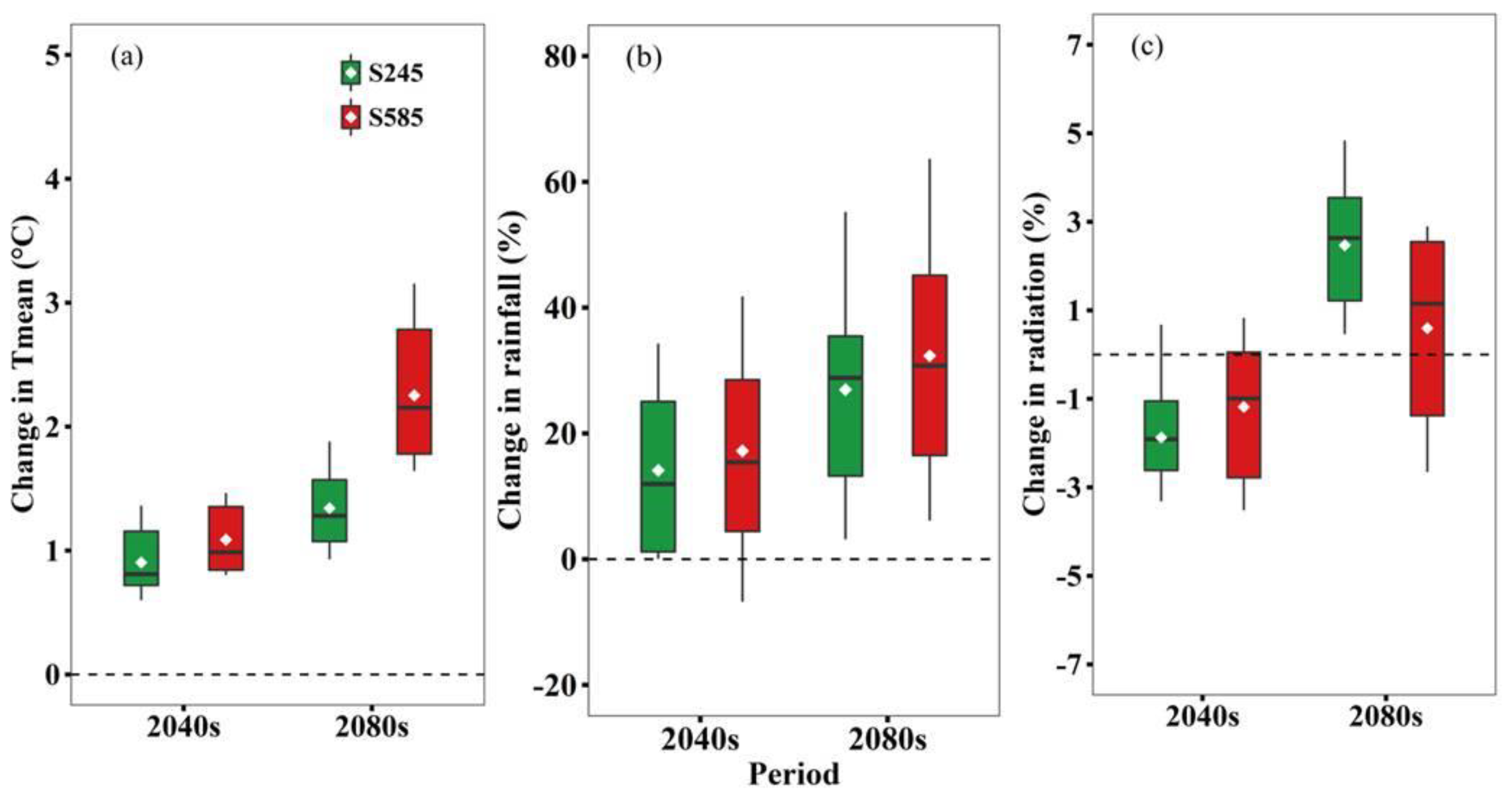
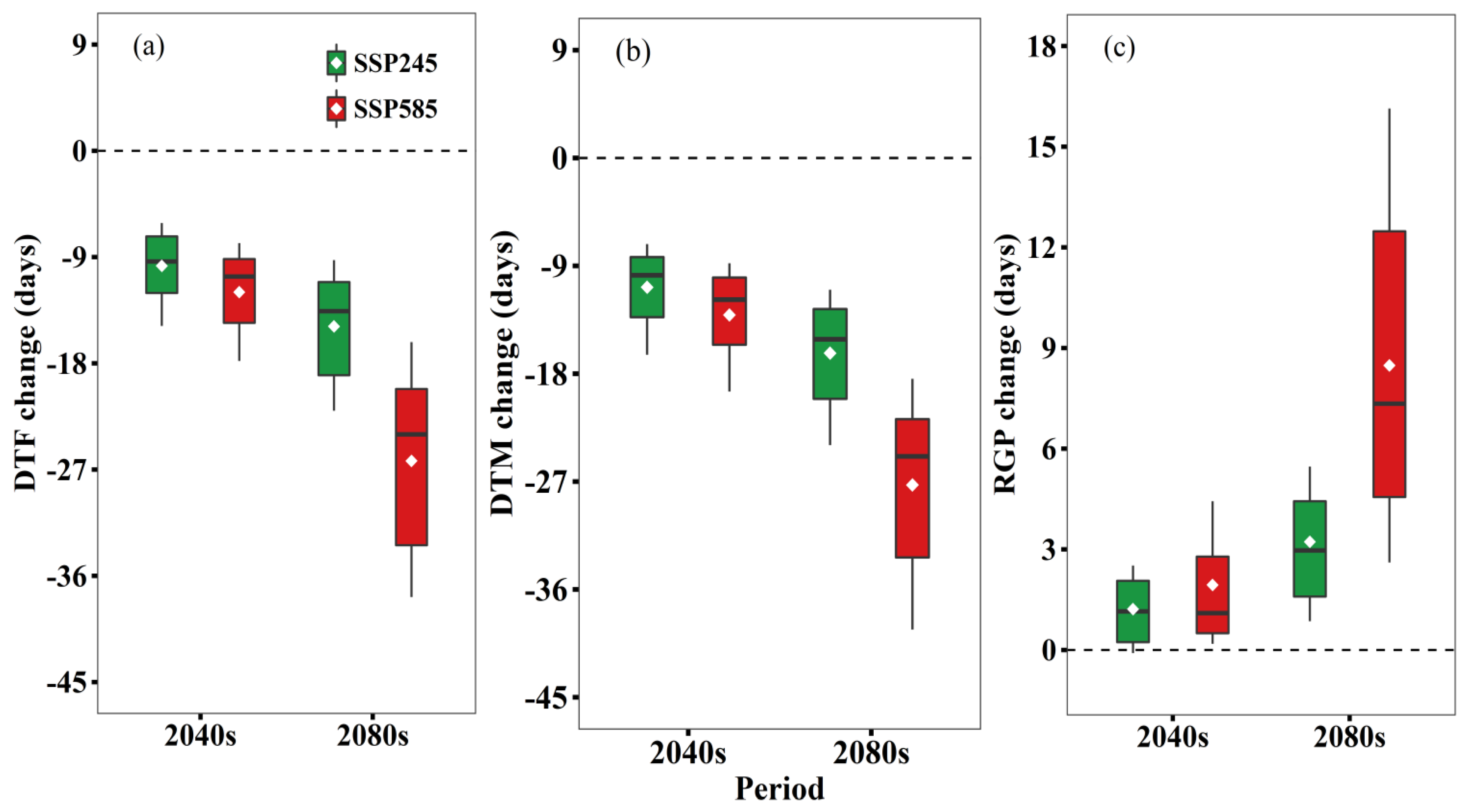
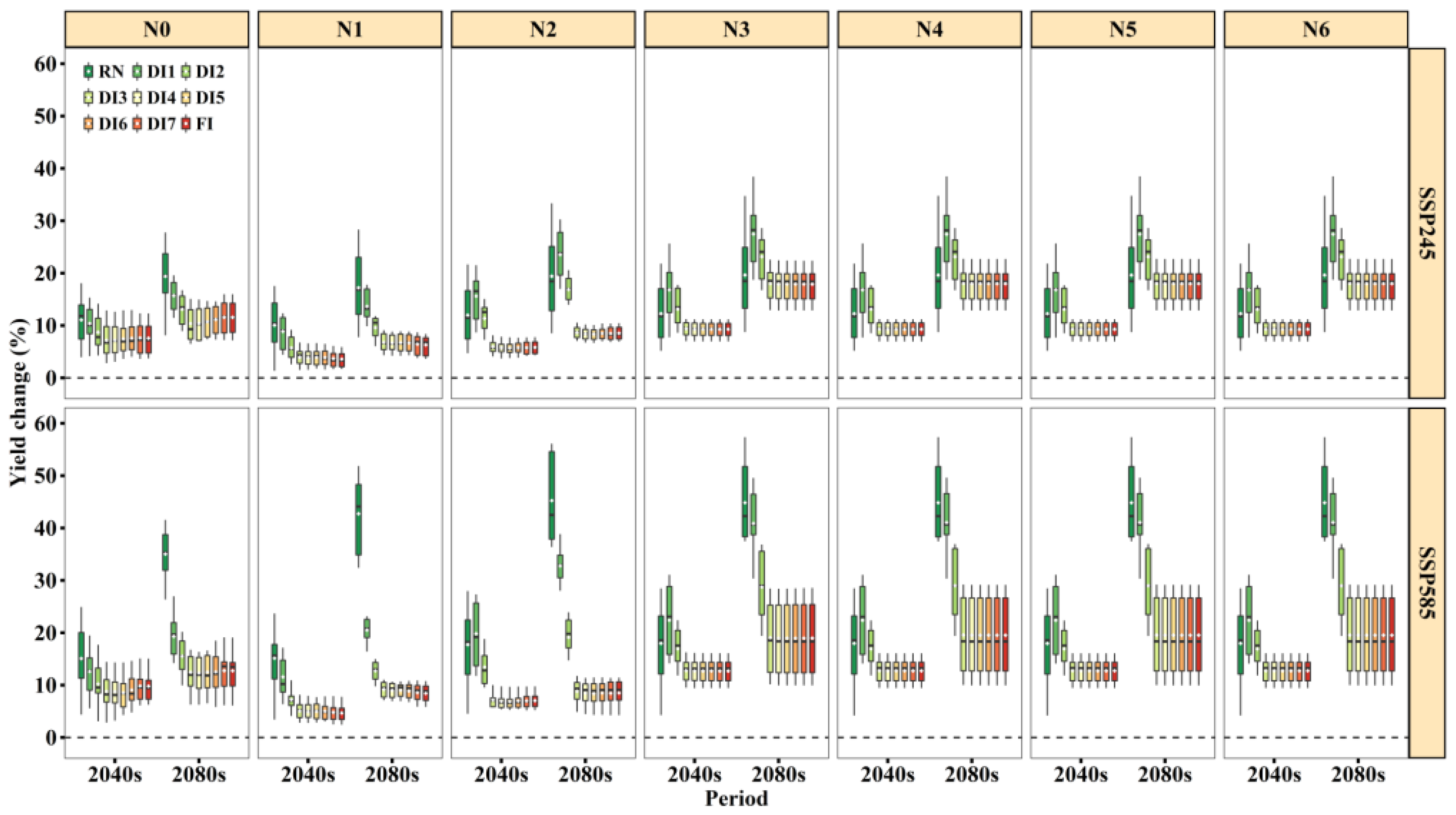
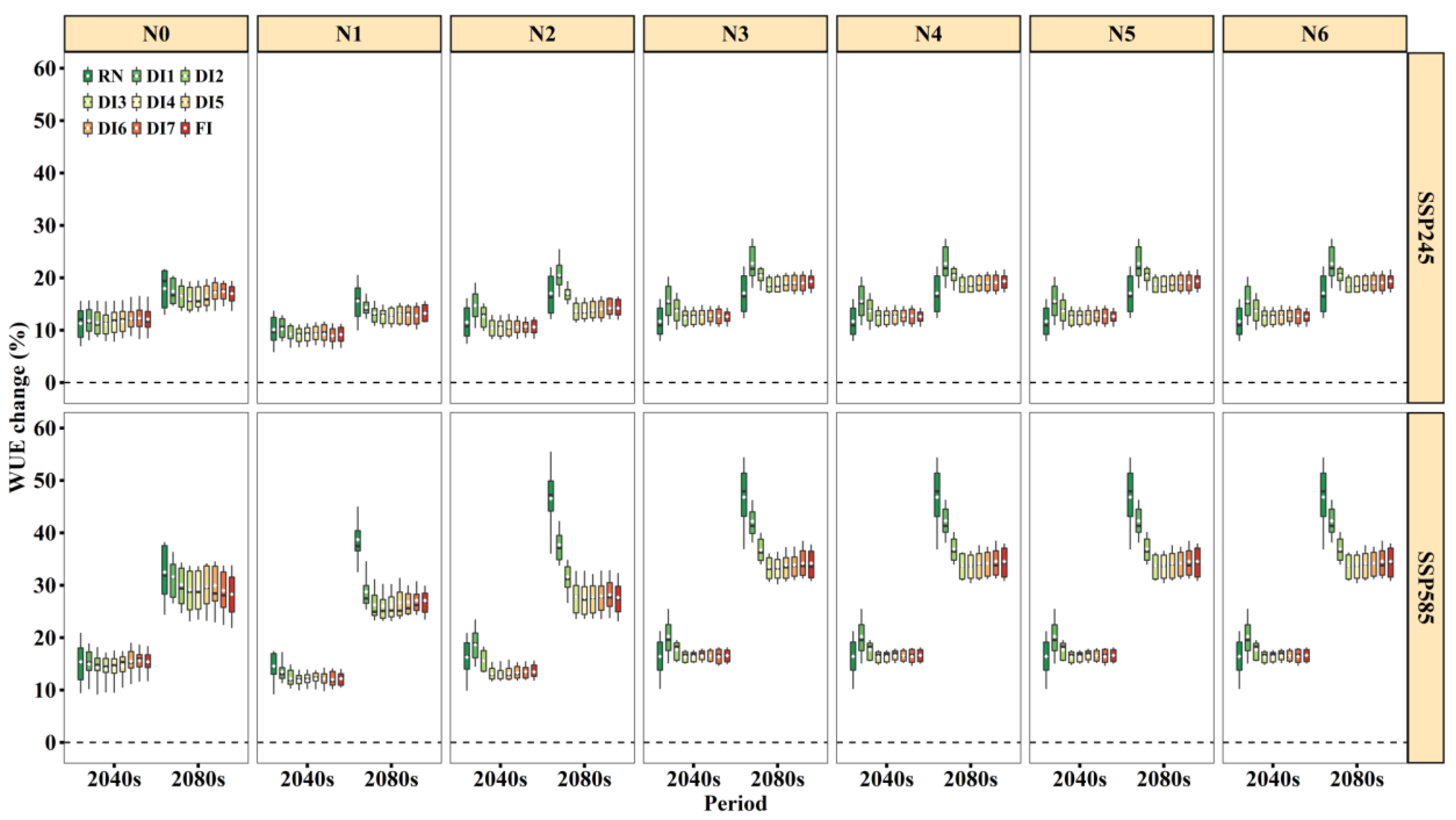
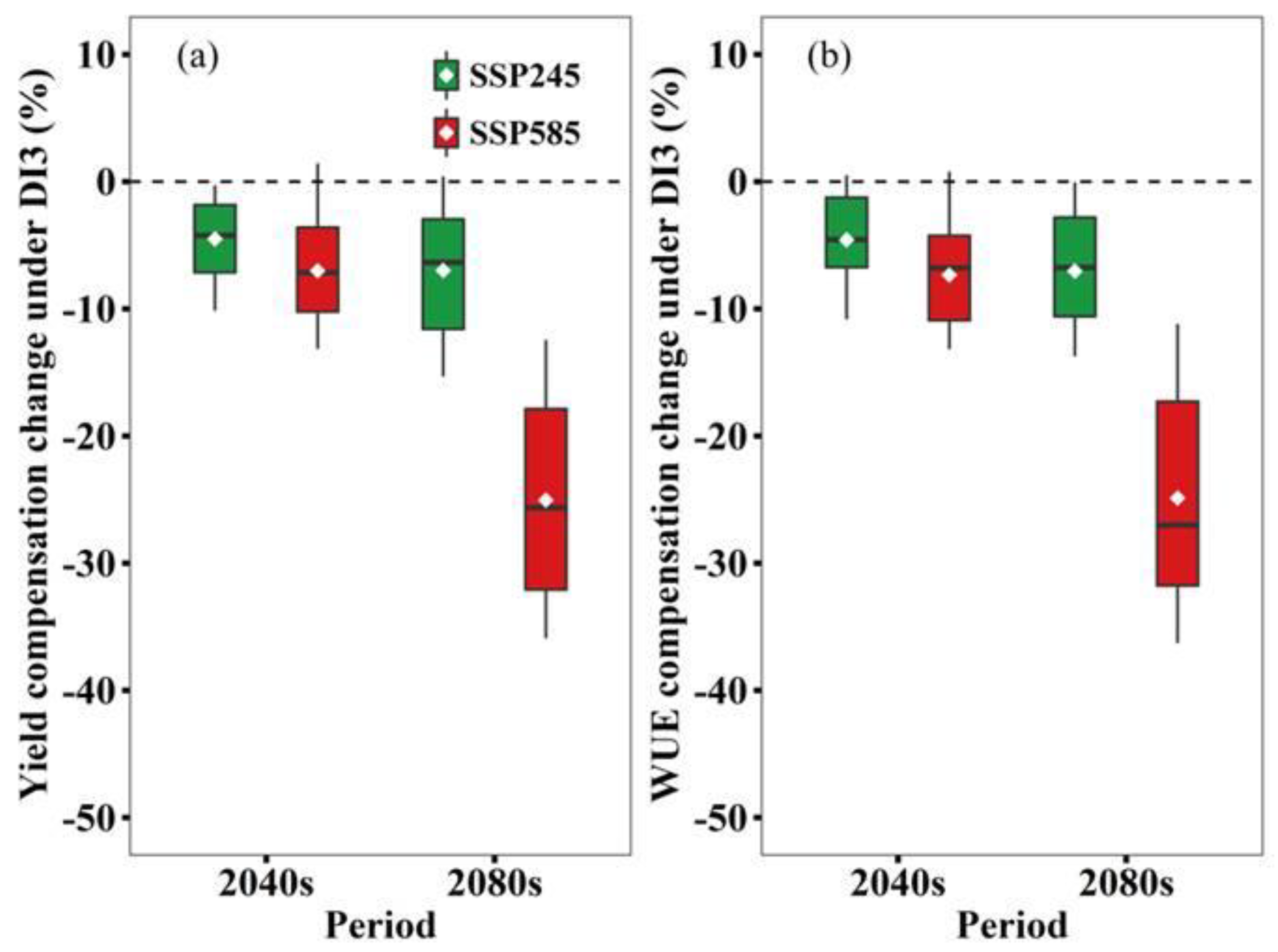
| Depth (cm) | Bulk Density (g cm−3) | Air Dry (mm/mm) | LL15 (mm/mm) | DUL (mm/mm) | SAT (mm/mm) |
|---|---|---|---|---|---|
| 0–20 | 1.300 | 0.080 | 0.090 | 0.310 | 0.360 |
| 20–40 | 1.320 | 0.108 | 0.120 | 0.270 | 0.310 |
| 40–60 | 1.350 | 0.120 | 0.150 | 0.260 | 0.300 |
| 60–80 | 1.350 | 0.130 | 0.160 | 0.250 | 0.300 |
| 80−100 | 1.350 | 0.150 | 0.180 | 0.250 | 0.290 |
| 100–120 | 1.350 | 0.150 | 0.180 | 0.240 | 0.290 |
| 120–160 | 1.350 | 0.160 | 0.180 | 0.240 | 0.290 |
| 160–200 | 1.400 | 0.160 | 0.190 | 0.220 | 0.386 |
| Month | Tmin (°C) | Tmax (°C) | Tmean (°C) | Rainfall (mm) | Radiation (MJ m−2) |
|---|---|---|---|---|---|
| October | 10.4 | 21.4 | 15.9 | 31.6 | 349.6 |
| November | 3.4 | 13.9 | 8.7 | 19.8 | 268.0 |
| December | −2.5 | 7.3 | 2.4 | 5.5 | 225.5 |
| January | −4.3 | 5.4 | 0.5 | 4.3 | 238.7 |
| February | −1.8 | 8.4 | 3.3 | 8.6 | 299.2 |
| March | 3.5 | 14.7 | 9.1 | 16.2 | 410.7 |
| April | 9.9 | 21.4 | 15.7 | 32.4 | 514.5 |
| May | 15.5 | 27.2 | 21.4 | 42.9 | 593.8 |
| June | 20.2 | 31.8 | 26.0 | 65.6 | 599.1 |
| Treatments | Irrigation Treatments under Controlled Deficit Irrigation | N Fertilizer Rates (kg N ha−1) | ||
|---|---|---|---|---|
| Sowing to Flowering Stage | Flowering to Grain Filling Stage | Grain Filling Stage to Maturity | ||
| A0 | 60–75% | 75–100% | 65–100% | 0 |
| A1 | 80–95% | 75–100% | 65–100% | 240 |
| A2 | 80–95% | 75–100% | 65–100% | 300 |
| A3 | 80–95% | 75–100% | 65–100% | 360 |
| A4 | 60–75% | 75–100% | 65–100% | 240 |
| A5 | 60–75% | 75–100% | 65–100% | 300 |
| A6 | 60–75% | 75–100% | 65–100% | 360 |
| A7 | 50–65% | 75–100% | 65–100% | 240 |
| A8 | 50–65% | 75–100% | 65–100% | 300 |
| A9 | 50–65% | 75–100% | 65–100% | 360 |
| Subset | Data Source | Sowing Date | Harvest Date | Treatments | Observed Data |
|---|---|---|---|---|---|
| Calibration | Auto-rain-shelter experiment (2017–2018) | 2 November 2017 | 8 June 2018 | A0–A9 (see Table 3) | Phenology, biomass, yield, WUE |
| Validation | Field experiment 1 (2016–2017) | 17 October 2016 | 10 June 2017 | N1: 240 kg N ha−1, 90 mm IA | Phenology, biomass, yield, WUE |
| N2: 180 kg N ha−1, 90 mm IA | |||||
| N3: 90 kg N ha−1, 90 mm IA | |||||
| N4: 0 kg N ha−1, 90 mm IA | |||||
| N5: 240 kg N ha−1, 0 mm IA | |||||
| N6: 180 kg N ha−1, 0 mm IA | |||||
| N7: 90 kg N ha−1, 0 mm IA | |||||
| N8: 0 kg N ha−1, 0 mm IA | |||||
| Field experiment2 (2014−2016) (Kumar Jha et al., 2019) | 18 October 2014 | 6 June 2015 | F1: FI: 50% of FC; TIA: 120 mm | Biomass, yield, WUE | |
| F2: FI: 60% of FC; TIA: 180 mm | |||||
| F3: FI: 70% of FC; TIA: 240 mm | |||||
| 15 October 2015 | 3 June 2016 | F1: FI: 50% of FC; TIA: 120 mm | |||
| F2: FI: 60% of FC; TIA: 180 mm | |||||
| F3: FI: 70% of FC; TIA: 240 mm | |||||
| Field experiment 3 (2017–2018) (Zhao et al., 2020) | 15 October 2017 | 10 October 2018 | N0: 0 kg N ha−1; N100: 100 kg N ha−1; N200: 200 kg N ha−1; | Yield | |
| N300: 300 kg N ha−1 |
| Model ID | Name of GCM | Abbr. of GCM | Institute ID | Country |
|---|---|---|---|---|
| 01 | ACCESS–CM2 | ACM | CSIRO–BOM | Australia |
| 02 | ACCESS–ESM1–5 | AE5 | CSIRO–BOM | Australia |
| 03 | BCC–CSM2–MR | BCM | BCC | China |
| 04 | CanESM5 | Ca5 | CCCMA | Canada |
| 05 | CanESM5–CanOE | CaC | CCCMA | Canada |
| 06 | CNRM–CM | CCM | CNRM | France |
| 07 | CNRM–ESM | CES | CNRM | France |
| 08 | EC–Earth3 | EE3 | EC–EARTH | Europe |
| 09 | EC–Earth3–Veg | EEV | EC–EARTH | Europe |
| 10 | FGOALS–g3 | FG3 | FGOALS | China |
| 11 | GFDL–ESM4 | GE4 | NOAA GFDL | USA |
| 12 | GISS–E2–1–G | GEG | NASA GISS | USA |
| 13 | INM–CM5–0 | IC0 | INM | Russia |
| 14 | INM–CM4–8 | IC8 | INM | Russia |
| 15 | IPSL–CM | ICM | IPSL | France |
| 16 | MIROC6 | MC6 | MIROC | Japan |
| 17 | MIROC–ES2L | ME2 | MIROC | Japan |
| 18 | MPI–ESM1–2–HR | MEH | MPI–M | Germany |
| 19 | MPI–ESM1–2–LR | MEL | MPI–M | Germany |
| 20 | MRI–ESM | MEM | MPI–M | Germany |
| 21 | UKESM1–0–LL | U0L | NCAS | UK |
| Name | Definition | Unit | Aikang58 |
|---|---|---|---|
| photop_sens | Photoperiod sensitivity | − | 3.5 |
| vern_sens | Vernalization sensitivity | − | 2 |
| tt_end_of_juvenile | Thermal time from sowing to end of the juvenile | °C day | 570 |
| startgf_to_mat | Thermal time from beginning of grain-filling to maturity | °C day | 580 |
| tt_floral_initiation | Thermal time from floral initiation to flowering | °C day | 570 |
| tt_start_grain_fill | Thermal time from the start of grain filling to maturity | °C day | 700 |
| max_grain_size | Maximum grain size | g | 0.047 |
| potential_grain_filling rate | Potential daily grain filling rate | g grain−1 day−1 | 0.004 |
| grains_per_gram_stem | Grain number per stem weight at the start of grain filling | g | 25 |
| y_frac_leaf | Fraction of remaining dry matter allocated to leaves | − | 0.3 |
| x_stem_wt | Stem weight per plant | g/plant | 6 |
| y__height | Plant canopy height | mm | 1500 |
| Treatment | Output Indicator | a | b | c | d | e | f | F0 | R2 |
|---|---|---|---|---|---|---|---|---|---|
| RN | ΔY | −217.6 *** | 18.5 *** | −62.8 *** | 357.7 *** | − | 0.84 *** | −5050 *** | 0.81 |
| ΔWUE | −0.70 *** | 0.01 ** | −0.20 *** | 1.10 *** | − | 0.02 *** | −13.2 *** | 0.82 | |
| Irrigation | ΔY | −53.7 ** | − | −16.9 *** | 177.6 *** | 6.77 *** | 22.7 *** | 320.2 *** | 0.77 |
| ΔWUE | −0.46 *** | − | −0.10 *** | 0.58 *** | 0.002 *** | 0.03 *** | 0.46 *** | 0.80 |
Publisher’s Note: MDPI stays neutral with regard to jurisdictional claims in published maps and institutional affiliations. |
© 2022 by the authors. Licensee MDPI, Basel, Switzerland. This article is an open access article distributed under the terms and conditions of the Creative Commons Attribution (CC BY) license (https://creativecommons.org/licenses/by/4.0/).
Share and Cite
Niu, X.; Feng, P.; Liu, D.-L.; Wang, B.; Waters, C.; Zhao, N.; Ma, T. Deficit Irrigation at Pre-Anthesis Can Balance Wheat Yield and Water Use Efficiency under Future Climate Change in North China Plain. Biology 2022, 11, 692. https://doi.org/10.3390/biology11050692
Niu X, Feng P, Liu D-L, Wang B, Waters C, Zhao N, Ma T. Deficit Irrigation at Pre-Anthesis Can Balance Wheat Yield and Water Use Efficiency under Future Climate Change in North China Plain. Biology. 2022; 11(5):692. https://doi.org/10.3390/biology11050692
Chicago/Turabian StyleNiu, Xiaoli, Puyu Feng, De-Li Liu, Bin Wang, Cathy Waters, Na Zhao, and Tiancheng Ma. 2022. "Deficit Irrigation at Pre-Anthesis Can Balance Wheat Yield and Water Use Efficiency under Future Climate Change in North China Plain" Biology 11, no. 5: 692. https://doi.org/10.3390/biology11050692








